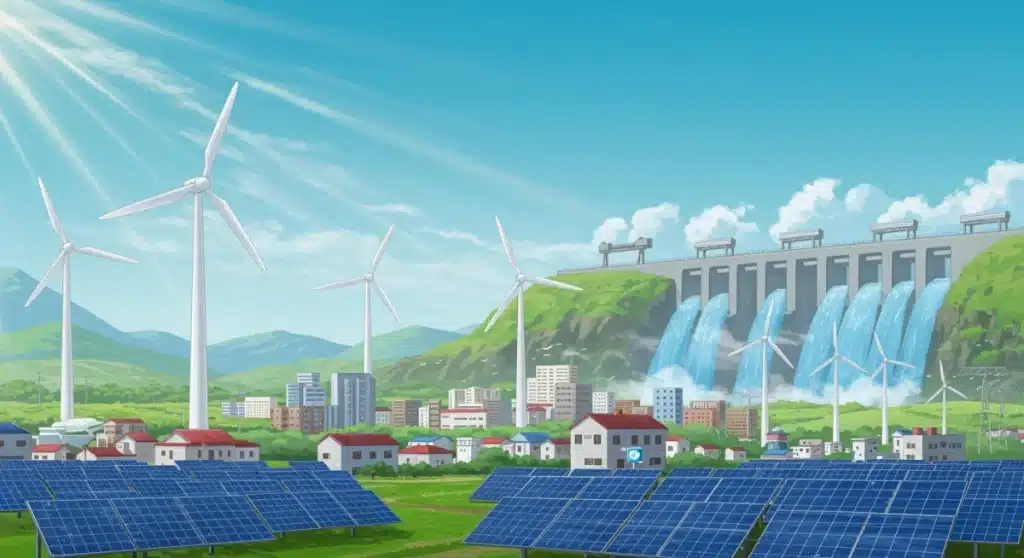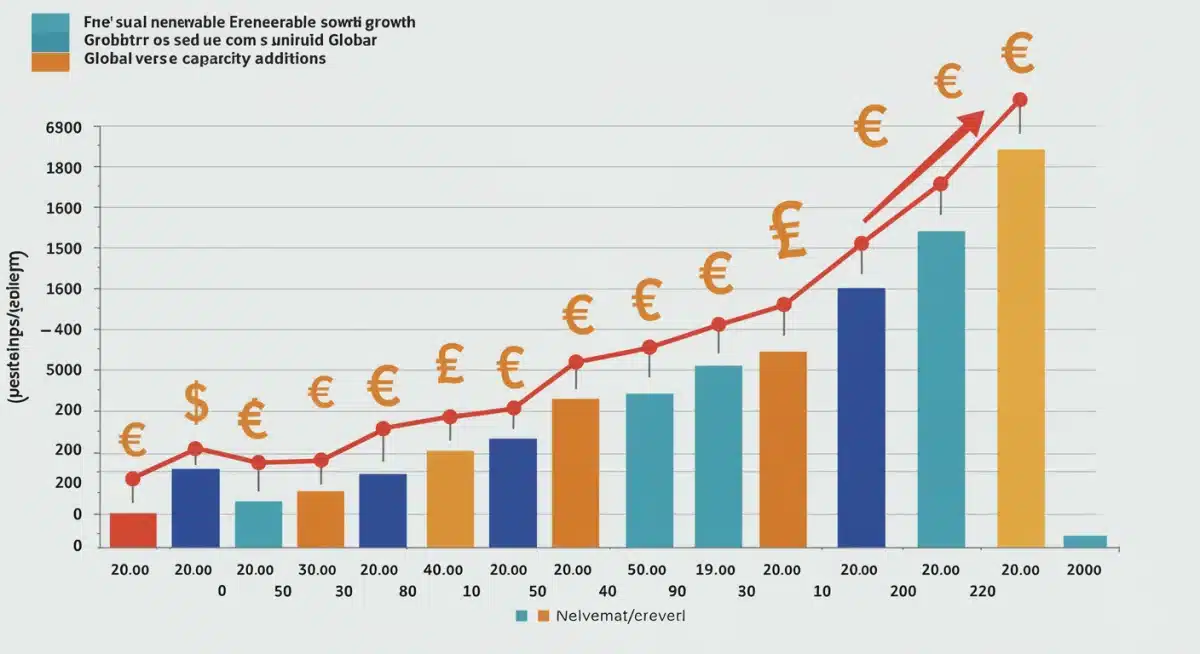Financial Benefits of New World Renewable Energy Investments

New world renewable energy investments deliver significant financial benefits, fueled by escalating demand, supportive policies, and continuous technological innovation across global markets.
Are you looking for investment opportunities that not only promise robust returns but also contribute to a sustainable future? The landscape of global finance is rapidly shifting, placing a premium on green initiatives. Understanding the financial benefits of investing in new world renewable energy projects is crucial for modern investors seeking both profit and purpose.
The Accelerating Growth of Renewable Energy Markets
The renewable energy sector is experiencing unprecedented expansion, driven by global commitments to decarbonization and increasing energy demand. This surge is creating fertile ground for investors, with market projections consistently showing significant year-over-year growth.
Governments worldwide are implementing policies that support clean energy, including subsidies, tax incentives, and regulatory frameworks designed to accelerate the transition away from fossil fuels. These supportive measures de-risk investments and enhance profitability, making renewable projects increasingly attractive.
Policy Drivers and Market Expansion
Recent developments in policy, such as the Inflation Reduction Act in the United States and the European Green Deal, are channeling billions into renewable energy infrastructure. These legislative actions provide long-term certainty for investors, fostering a stable environment for capital deployment.
- Tax Credits: Generous tax credits for solar, wind, and other renewable technologies significantly reduce project costs.
- Subsidies and Grants: Direct financial support for research, development, and deployment of innovative clean energy solutions.
- Regulatory Mandates: Renewable Portfolio Standards (RPS) in various regions compel utilities to source a percentage of their electricity from renewables.
The market is not just expanding in traditional areas like solar and wind; emerging technologies such as green hydrogen, advanced geothermal, and tidal energy are also drawing considerable interest. This diversification offers a broader range of investment avenues, allowing investors to spread risk and capitalize on different growth trajectories.
Enhanced Returns and Long-Term Stability
Investing in renewable energy projects often yields stable and predictable cash flows, making them an attractive option for institutional investors and individuals alike. Once operational, these projects typically have low variable costs and long operational lifespans, providing consistent returns over several decades.
Power Purchase Agreements (PPAs) are a cornerstone of financial stability in this sector. These long-term contracts guarantee a buyer for the electricity produced at a predetermined price, insulating projects from market price volatility. This contractual certainty is a significant de-risker, enhancing the long-term financial viability of projects.
Predictable Revenue Streams
Unlike fossil fuel projects, which are subject to volatile commodity prices, renewable energy projects benefit from fixed-price contracts. This predictability allows for accurate financial modeling and reduces investment uncertainty.
- Fixed-Price PPAs: Secure revenue for 10-25 years, often with inflation escalators.
- Low Operational Costs: Minimal fuel costs and increasingly efficient maintenance protocols.
- Government Support: Continued policy backing reduces regulatory risks and enhances project economics.
Moreover, the decreasing cost of renewable energy technologies, particularly solar photovoltaics and wind turbines, means that new projects are becoming even more competitive. This cost reduction translates directly into higher profit margins and more attractive investment opportunities, even without subsidies in many regions.
Mitigating Investment Risks Through Diversification
Adding renewable energy investments to a portfolio can significantly enhance diversification. The performance of renewable assets often correlates differently with traditional asset classes, providing a hedge against market downturns in other sectors. This can lead to a more resilient and stable overall investment portfolio.
Geographical diversification within the renewable energy sector also plays a crucial role. Investing in projects across different regions or countries can mitigate risks associated with local weather patterns, regulatory changes, or specific market conditions. For example, a portfolio might include solar projects in sunny regions and wind projects in windy areas, balancing seasonal fluctuations.
Hedging Against Volatility
The inherent stability of renewable energy revenue streams acts as a counter-cyclical force during economic uncertainties. While other sectors might struggle with demand fluctuations or supply chain disruptions, the essential nature of electricity generation ensures continued operation and revenue.
Furthermore, the increasing global focus on ESG (Environmental, Social, and Governance) factors means that companies with strong sustainability profiles are increasingly favored by investors. Renewable energy investments inherently align with the ‘E’ in ESG, attracting capital from a growing pool of socially conscious funds and investors.
Technological Innovation Driving Efficiency and Profitability
Rapid advancements in renewable energy technology are continuously improving efficiency and reducing costs. Innovations in solar panel technology, wind turbine design, battery storage solutions, and smart grid integration are making renewable energy more competitive and reliable than ever before.
These technological leaps not only enhance energy output but also extend the lifespan of equipment and reduce maintenance requirements. For investors, this translates into higher internal rates of return (IRRs) and improved project economics. The pace of innovation shows no signs of slowing, promising even greater efficiencies in the future.

Battery storage, in particular, is a game-changer. It addresses the intermittency challenge of renewables, allowing for continuous power supply even when the sun isn’t shining or the wind isn’t blowing. This integration makes renewable energy a more reliable and dispatchable power source, increasing its value proposition.
Key Innovations Impacting Returns
Several areas of technological development are directly impacting the financial attractiveness of renewable energy projects:
- Advanced Solar Panels: Higher efficiency rates and lower manufacturing costs per watt.
- Larger Wind Turbines: Increased capacity factors and ability to harness stronger winds at higher altitudes.
- Grid Modernization: Smart grid technologies optimize energy distribution and reduce losses.
- Energy Storage Solutions: Lithium-ion and emerging battery chemistries provide critical grid stability and arbitrage opportunities.
The synergy between these technologies creates a robust ecosystem for renewable energy generation and distribution, solidifying its role as a primary power source and a sound investment.
Access to Sustainable Finance and ESG Compliance
The global financial community is increasingly prioritizing sustainable investments. Funds and institutions are actively seeking out opportunities that meet stringent Environmental, Social, and Governance (ESG) criteria. Renewable energy projects inherently align with these criteria, making them highly attractive to a growing pool of capital.
This surge in sustainable finance means that renewable energy projects often have easier access to capital, sometimes at more favorable terms. Banks and financial institutions are developing specific green financing products, including green bonds and sustainability-linked loans, to support these initiatives.
The ESG Investment Premium
Companies and projects with strong ESG credentials often experience a ‘green premium,’ attracting more investment and potentially commanding higher valuations. This is not just a trend but a fundamental shift in how investment value is perceived in the modern economy.
- Green Bonds: A rapidly growing market providing dedicated funding for environmentally beneficial projects.
- ESG Funds: Dedicated investment vehicles focusing on companies with high sustainability ratings.
- Reputational Benefits: Investing in renewables enhances corporate image and attracts socially conscious talent and customers.
Moreover, regulatory bodies are increasingly mandating ESG disclosures, pushing more capital towards sustainable sectors. This regulatory push, combined with investor demand, ensures a continuous flow of funds into renewable energy, reinforcing its financial benefits.
Global Energy Transition and Future Prospects
The transition to a global clean energy economy is not merely an environmental imperative but also a monumental economic opportunity. As countries commit to net-zero emissions, the demand for renewable energy sources will continue to skyrocket, creating enormous investment potential.
This transition involves not only electricity generation but also the electrification of transport, heating, and industrial processes. Each of these areas presents new markets and growth avenues for renewable energy technologies and related infrastructure. The scale of this transformation ensures that renewable energy will remain a dominant investment theme for decades to come.
Emerging Markets and Untapped Potential
Developing nations, with their rapidly growing energy needs and abundant renewable resources, represent significant untapped potential. Investments in these markets can offer higher growth rates and contribute significantly to global sustainable development goals.
The International Energy Agency (IEA) consistently highlights renewable energy as the fastest-growing source of electricity generation globally. This sustained growth, coupled with ongoing policy support and technological innovation, paints a very optimistic picture for future investments.
| Key Financial Benefit | Brief Description |
|---|---|
| Stable Returns | Long-term PPAs provide predictable revenue, reducing market volatility risks for investors. |
| Policy Incentives | Government tax credits and subsidies enhance project profitability and reduce initial costs. |
| Technological Advancements | Innovations continually lower costs and boost efficiency, increasing investment attractiveness. |
| ESG Appeal | Attracts capital from a growing pool of socially responsible and sustainability-focused funds. |
Frequently Asked Questions About Renewable Energy Investments
Renewable energy investments are attractive due to long-term power purchase agreements, decreasing technology costs, and strong government incentives like tax credits. These factors contribute to stable, predictable revenue streams for investors over extended periods.
Government policies, including tax incentives, subsidies, and renewable energy mandates, significantly boost profitability by reducing initial capital costs and guaranteeing market demand. They de-risk projects, making them more appealing to a broader range of investors.
Yes, renewable energy investments often exhibit lower volatility. Unlike fossil fuels, which are subject to fluctuating commodity prices, renewables benefit from fixed-price contracts and stable operational costs, providing more predictable financial performance and hedging against market swings.
Technological advancements are crucial. They continuously lower the cost of renewable energy generation, improve efficiency, and enhance reliability through innovations like better solar panels, larger wind turbines, and advanced battery storage, directly boosting project returns.
ESG compliance is vital as it aligns investments with global sustainability goals, attracting a growing pool of capital from ethically conscious funds and institutions. It can lead to easier access to financing and potentially higher valuations for projects meeting these criteria.
Looking Ahead
The financial benefits of investing in new world renewable energy projects are poised to expand further as the global energy transition accelerates. With continued technological breakthroughs, robust policy support, and increasing demand for sustainable solutions, the sector will remain a cornerstone of economic growth and environmental stewardship. Investors should monitor emerging markets and evolving regulatory landscapes, as these will likely present the next wave of significant opportunities in green finance. The trajectory is clear: renewable energy is not just an alternative; it is the future of energy and a smart investment.